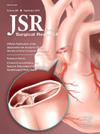Trends in the Management of Peripheral Arterial Injuries: A Five-Year National Analysis
IF 1.7
3区 医学
Q2 SURGERY
引用次数: 0
Abstract
Introduction
Peripheral vascular injuries are rare with high rates of morbidity and long-term sequelae. The aim of this study is to study the trends in vascular injuries and management across American College of Surgeons–verified Level I trauma centers.
Methods
We performed a 5-y retrospective analysis of the American College of Surgeons Trauma Quality Improvement Program database for the years 2017-2021. We included all patients with peripheral arterial injuries (axillary, brachial, radial, ulnar, femoral, popliteal, and tibial arteries) that underwent open or endovascular repair. Trauma centers were stratified into tertiles based on the volume of these vascular injuries into low volume (LV), medium volume (MV), and high volume (HV) centers. The primary outcome was rates of open and endovascular repair. The secondary outcome was amputation. Descriptive statistics and trend analysis were performed.
Results
We identified a total of 22,057 patients with peripheral arterial injuries managed at 340 trauma centers (243 LV; 73 MV; 24 HV). Overall, the mean age was 36 (16) y; 83% were male. Nearly 30% sustained blunt injuries with a median injury severity score of 9 [3-13]. HV centers deal with an average of 27 cases/y. The rates of open and endovascular repairs were 63% and 13%, respectively. HV centers were more likely to perform endovascular repair (LV 11% versus MV 12% versus HV 14%, P < 0.001). There was no clinically significant difference between the HV, MV, and LV centers in terms of amputations (HV: 2.9% versus MV: 3% versus LV: 2.5%). On linear regression analysis, the proportion of endovascular procedures has linearly increased from 12% in 2017 to 14% in 2021 (β = 0.013, 95% confidence interval = 0.010-0.016, P < 0.001).
Conclusions
Peripheral arterial injuries remain a complex clinical challenge. Nearly one-third of the peripheral arterial injuries are due to blunt mechanisms. Open repair remains the most preferred method of management. However, the outcomes remain equivocal irrespective of volume. Current training programs need to identify ways to improve training in open repairs for vascular injuries.
外周动脉损伤管理的趋势:一项五年全国分析
外周血管损伤是一种罕见的疾病,其发病率高且有长期的后遗症。本研究的目的是研究美国外科医师学会认证的一级创伤中心血管损伤和管理的趋势。方法对2017-2021年美国外科医师学会创伤质量改善计划数据库进行5年回顾性分析。我们纳入了所有接受开放或血管内修复术的外周动脉损伤(腋动脉、肱动脉、桡动脉、尺动脉、股动脉、腘动脉和胫动脉)患者。根据这些血管损伤的体积将创伤中心分层为低容量(LV)、中容量(MV)和高容量(HV)中心。主要观察指标为血管内修复率和血管内修复率。次要结局是截肢。进行描述性统计和趋势分析。结果在340个创伤中心(243个左室;73 MV;24高压)。总体而言,平均年龄为36(16)岁;83%是男性。近30%的患者为钝性损伤,损伤严重程度评分中位数为9分[3-13]。艾滋病中心平均每年处理27个病例。开放修复率和血管内修复率分别为63%和13%。HV中心更有可能进行血管内修复(LV 11% vs MV 12% vs HV 14%, P <;0.001)。在截肢方面,HV、MV和LV中心之间没有临床显著差异(HV: 2.9% vs MV: 3% vs LV: 2.5%)。在线性回归分析中,血管内手术的比例从2017年的12%线性增加到2021年的14% (β = 0.013, 95%置信区间= 0.010-0.016,P <;0.001)。结论外周动脉损伤仍然是一个复杂的临床难题。近三分之一的外周动脉损伤是由钝器造成的。开放式修复仍然是最受欢迎的治疗方法。然而,无论数量多少,结果都是模棱两可的。目前的训练计划需要确定方法来改进血管损伤开放性修复的训练。
本文章由计算机程序翻译,如有差异,请以英文原文为准。
求助全文
约1分钟内获得全文
求助全文
来源期刊
CiteScore
3.90
自引率
4.50%
发文量
627
审稿时长
138 days
期刊介绍:
The Journal of Surgical Research: Clinical and Laboratory Investigation publishes original articles concerned with clinical and laboratory investigations relevant to surgical practice and teaching. The journal emphasizes reports of clinical investigations or fundamental research bearing directly on surgical management that will be of general interest to a broad range of surgeons and surgical researchers. The articles presented need not have been the products of surgeons or of surgical laboratories.
The Journal of Surgical Research also features review articles and special articles relating to educational, research, or social issues of interest to the academic surgical community.

 求助内容:
求助内容: 应助结果提醒方式:
应助结果提醒方式:


